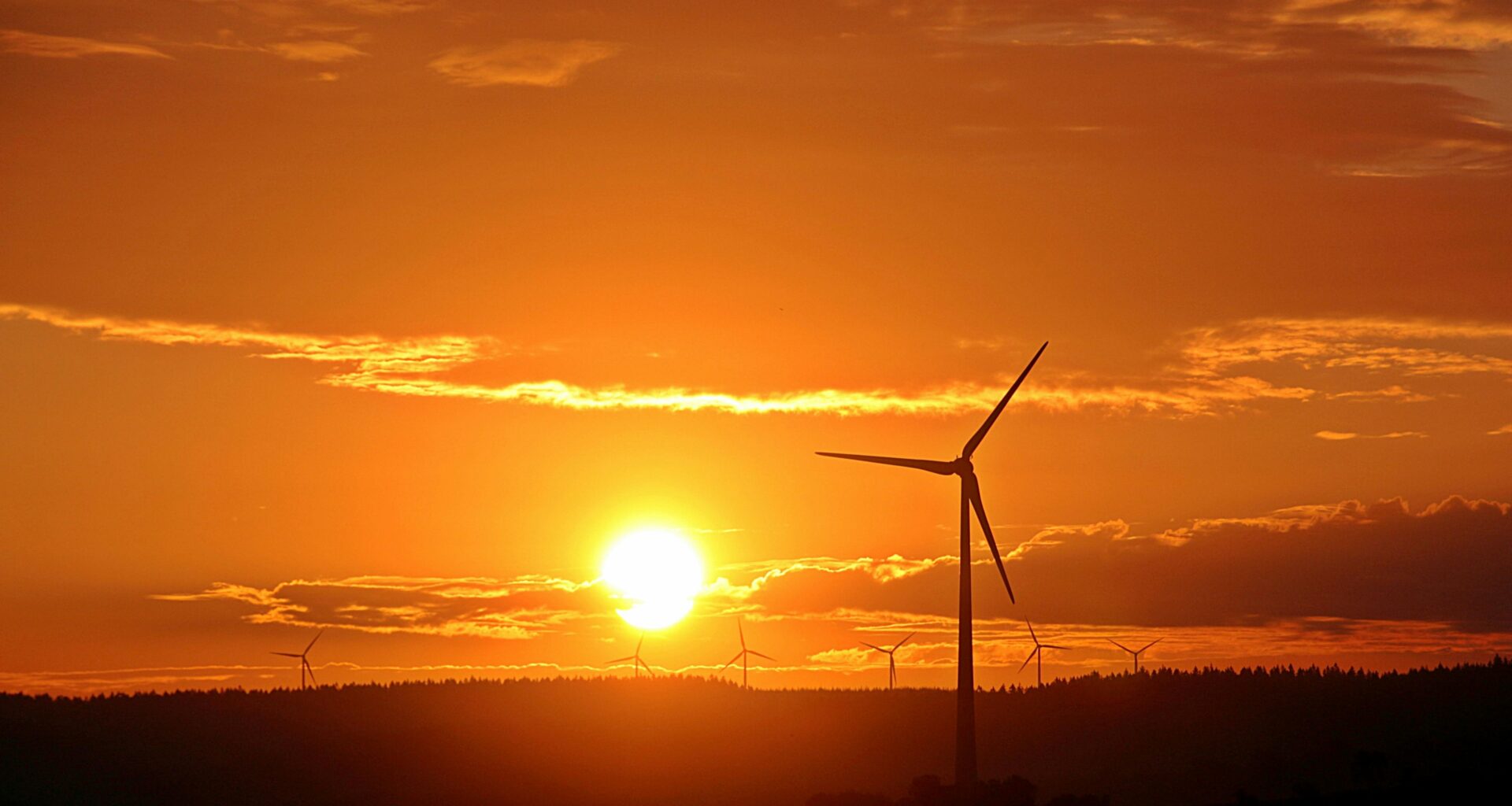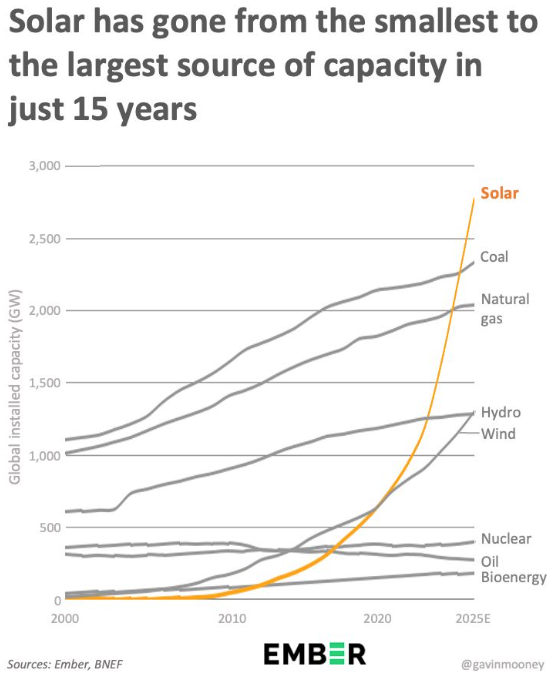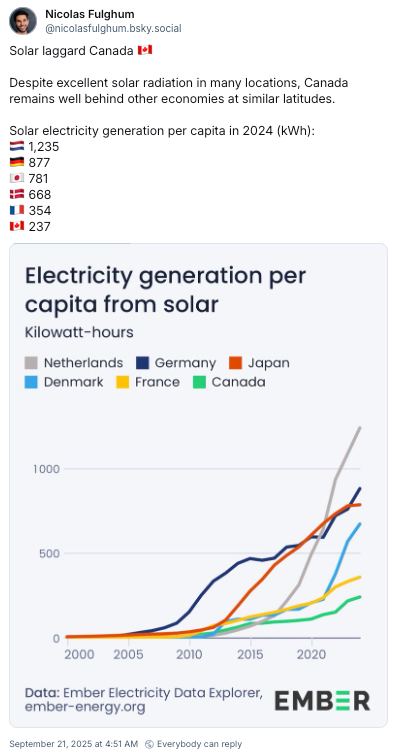It’s Thanksgiving, so let’s take some time around the table to appreciate some big things that are actually going right in this climate mess. We’ll try to keep our inner grouchy uncle in check but even the old grump might end up acknowledging that some happenings are sunnier than expected. So gather around because here comes the cook with an amuse-bouche: news that, in the first half of 2025, and for the first time ever, renewables produced more energy than coal.
Dethroning King Coal is no small matter. As archaic as it sounds, coal burning remains the world’s biggest source of carbon pollution. When renewables overtake coal, “[w]e are seeing the first signs of a crucial turning point,” said Małgorzata Wiatros-Motyka, one of the analysts at Ember, the thinktank that crunched the numbers and announced the good news.
Actual power generation is the crucial measure, but if you look at installed capacity, the picture is even more striking.
Wonkier, but perhaps even sunnier news: solar and wind are growing so quickly that they outpaced all the growth in electricity demand this year. Which means they started eating into fossil fuelled power, leading to a modest but significant drop in fossil generation and a small decline in global CO2 emissions from the power sector. Fossil generation dropped in both China and India.
“Yes, but…” protests the inner grump, unable to savour the moment. “That’s only electricity generation and renewables are only, barely, covering the growth in electricity demand, not the whole spew.” The old grouch is annoyingly accurate sometimes.
But it is also true that most people, and even most energy pros, have not kept up with the exponential rate of change in clean energy. And, to rectify that, we can turn to a veteran guide through climate science, climate movements and the quest to replace fossil fuels. Bill McKibben is a veteran, even among veterans, having written the first book about climate change for a lay audience, The End of Nature, in 1989.
Solar and wind are growing so quickly that they outpaced all the growth in electricity demand this year. Which means they started eating into fossil fuelled power, leading to a modest drop in fossil generation.
McKibben is a particularly useful guide, not only for his long perspective, but also because he isn’t a pasteurised, techno-utopian. He’s someone who understands that the drive away from fossil fuels will have to navigate the mucky human world, all while outmaneuvering the powerful polluters with all their wealth and incumbency.
He was not only the first journalist and chronicler of our climate predicament, but also among the early organizers and activists. You probably know at least parts of his bio: he co-founded 350.org, one of the first youth climate organizations back in 2008, a full decade before school strikes and student protests emerged. He’s been arrested protesting pipelines and received the Right Livelihood Award and Gandhi Peace Prize. Now 64 years young, McKibben recently co-founded Third Act, empowering elders to “protect the climate and strengthen democracy.” Along the way McKibben has written countless articles and newsletters (so absurdly prolific that “countless” is barely an exaggeration) and written 20 books, the most recent of which is Here Comes The Sun.
McKibben is known for “dark realism,” so when he trumpets the “one big good thing,” even the curmudgeons’ ears might perk up. The subtitle of this recent book is: A Last Chance for the Climate and a Fresh Chance for Civilization.
“There is one big good thing happening in the midst of all the big bad things that are happening on our planet, and it is going so far largely unnoticed,” says McKibben. “That’s the explosion over the last 36 months of renewable energy.”
We passed an important juncture back in June 2023, Mckibben writes. Two opposing ones, in fact. On the one hand, global temperatures leapt upwards, for reasons that are still not fully understood, but which appears to be an acceleration of global heating with fires and floods intensifying and almost every succeeding month exceeding the 1.5 C objective of the Paris Agreement.
At the same time, we reached the point where humanity was installing a gigawatt-worth of solar panels every day. A gigawatt is roughly the scale of a conventional power plant running on coal or nuclear power and when McKibben founded 350.org, it took a full year to install a single gigawatt. Since 2023 the deployment has kept accelerating and in the first half of 2025, the world has already installed 380 GW of new solar capacity.
Solar power is now 300 times cheaper than 40 years ago. The batteries that hold their power overnight are 90 per cent cheaper than 10 years ago (yes, Grouchy, we all know the sun doesn’t shine at night).
Renewables get hobbled by the outdated label “alternative energy,” writes McKibben. But we need to start recognizing them as the “new default.” In many parts of the world, it is now cheaper to build new renewable power than to keep existing fossils running.
“To say this rapid growth was unexpected would be an understatement,” Mckibben writes. And that partly explains why so many traditional energy professionals still haven’t grasped what’s going on. But, across the globe, regular people are switching to the sun at breakneck speed.
In Nigeria, Africa’s biggest petrostate, imports of solar panels jumped by two-thirds in the past year. Pakistan is experiencing one of the most rapid solar revolutions on the planet — a grassroots surge so quick and unexpected that its own grid operators only clued in because the demand for centralized power dropped.
In some places, the transition is more orderly. One of the stories McKibben likes to tell is about California, where renewables are now generating more than 100 per cent of the power it needs for parts of the day while batteries soak up the excess. At night they are often the biggest source of electricity to the grid of the world’s fifth-largest economy.
And here’s the kicker: “As a result, in 2024 California used 25 per cent less natural gas to produce its power than it had in 2023, which is a big number,” McKibben writes. Fast forward to this spring and the numbers get bigger. California is now using 44 per cent less natural gas for power than two years ago.
Another reason the energy traditionalists have been so slow to adapt is that so much of the story has been written in Chinese. China is installing more renewable power than the rest of the world, combined. And China absolutely dominates manufacturing, producing around 90 per cent of the world’s solar panels, over 70 per cent of batteries and wind turbines, and now more than 70 per cent of electric vehicles (buses, cars, high-speed rail, trucks, you name it).
But McKibben reminds us that this is not solely a tale about technology. The impetus came from activists and we should really be giving thanks to the German Greens. Long before China bet big on clean tech, the German Green party gained the balance of power and demanded a policy that came to be known as “feed-in-tariffs” — payments to people and coops producing renewable electricity. The German Energiewende paid the high, early price for “alternative energy” and became proof of concept, scaling a mass market that would ultimately drive the cost reductions still ongoing today. “It was an act of extraordinary generosity,” McKibben writes. “The country that had caused so many of the 20th century’s problems was doing more than any other to deal with the crises of the 21st.”
McKibben is most focused on the sun. And your inner cantankerous Canadian may well be objecting already that our days are getting shorter, and darker. What’s all very well for California or Pakistan ain’t gonna cut it during a Canadian winter. There’s some truth to that. But it is worth pointing out that Germany is no equatorial paradise — Berlin is at roughly the same latitude as Attawapiskat, Ont. — and solar grew to be the EU’s biggest power source for the first time in June of this year.
And the sun’s gifts are not confined to solar power. It beams constantly but lands differently, setting in motion the great aerial flows and currents. Wind power is really solar, one step removed. And most assessments find that wind should make up the bulk of new power to electrify a country like Canada.
As welcome as it may be, the rapid embrace of clean energy is no panacea. The rollout will be blocked by incumbents and we will still need to convert all our fossil fuelled machines to run on those clean electrons.
Meanwhile, time is not on our side. “I have little doubt we will run the world on sun and wind 40 years from now, but if it takes anything like 40 years to get there then it will be a broken planet,” writes McKibben.
And so, Here Comes The Sun is at once a flare calling attention to the energy revolution that is so much further underway than most of us realize and also a call to arms. To activism, “a lot more activism.” And a form that the veteran climate activist says must be double-barreled. “We can’t give up on ‘no,’ not in a world where giant corporations and their client governments are still doing dangerous things,” McKibben writes. But he urges that “The job now is not just to block bad things — it’s to build good ones.”
Even the grouchy uncle might have to admit it: something’s shifting. The dirtiest fuel on Earth has been knocked off its perch. Solar and wind are racing ahead. So before the pumpkin pie, maybe we take a moment of gratitude — thanks for the stubborn engineers and scrappy activists, for the rooftop tinkerers and policy wonks. And, yes, even the politicians and industrialists, whether they jumped in front of the clean-tech parade or offered themselves into the sausage-maker to help defend our beautiful planet.
This Thanksgiving, we can at least be grateful that the future is no longer theoretical — it’s powered up, and ready for us to plug in. And why don’t we allow McKibben a final blessing (unbelievably, on top of everything else, the guy was an occasional Sunday school teacher and still leads Christmas Eve services at his local Vermont church):
“In true Hollywood fashion,” says McKibben, “our liberation and our destruction are arriving at precisely the same time, offering us a remarkable choice. Our species, at what feels like a very dark moment, can take a giant leap into the light. Of the sun.”



